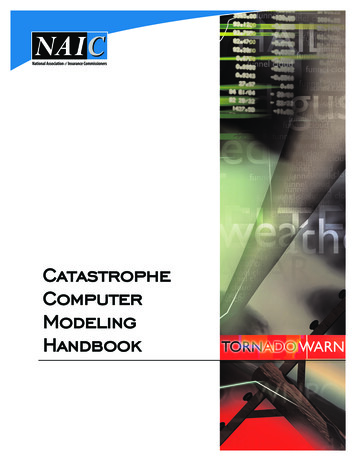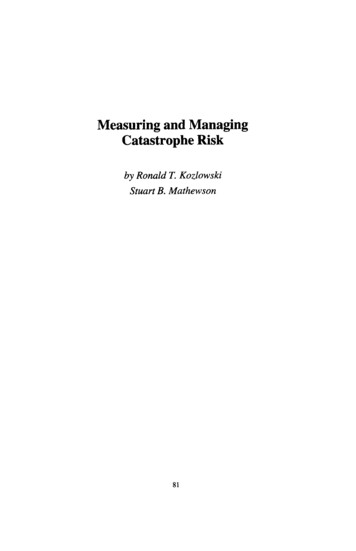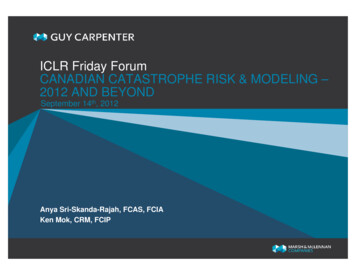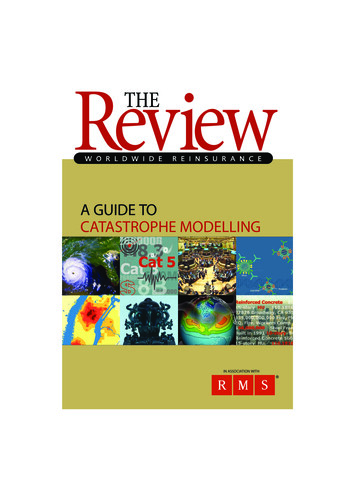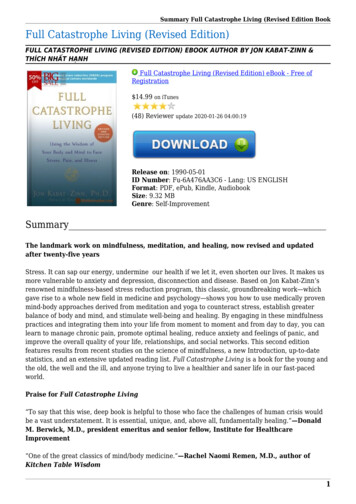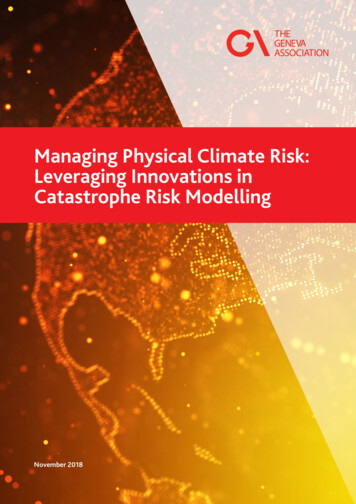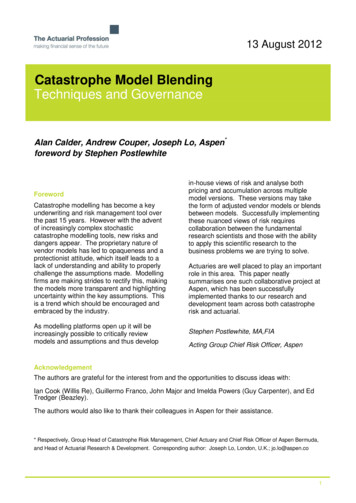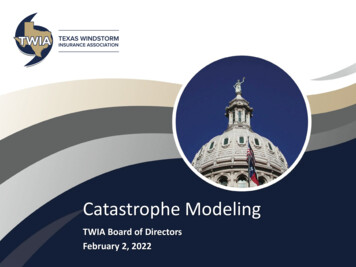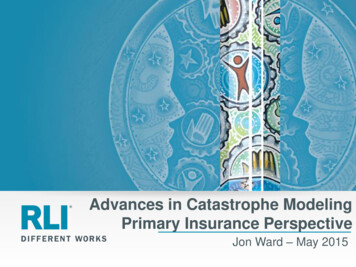
Transcription
Advances in Catastrophe ModelingPrimary Insurance PerspectiveJon Ward – May 2015
The Underwriter must be Empowered The foundational element of our industry is underwriting A model will never replace the underwriter Data is valuable - and more available than ever Use it to differentiateActive catastrophe management is possible Select risks, transact with knowledge, build a winning portfolio It’s the Underwriter’s job and reputation at risk Your Catastrophe Management department is a resource and is your friend!2
Catastrophe Models Are nothing more than tools in the Risk Management and Risk Selection process Help us understand the range of possibilities over the long term Create a common currency To compare and contrast risks For rating agency evaluation To communicate and trade with partners Provide guidance and benchmarking Evaluate many variables at one time Increase consistency Compare and contrast risks Create a baseline Optimize capital outlay Produce Numbers. With insurance, numbers are not as important as contractwordingCatastrophe Models are powerfultools. Like most powerful tools, itmust be implemented accuratelyand responsibly; in a mannerconsistent with its construction.3
Keep the Models In Their Place Maintaining recognition of what models can and cannot do is everyone’s job Recognize there is more uncertainty about cargo, boats, and cranes than singlefamily homes Are more accurate at the portfolio than at the location level Should be balanced with limits based metrics Limit surprises and increase preparedness In nearly all circumstances relating to insurance, surprises are bad Don’t be an outlier in a negative way Catastrophe Modeling is not a synonym for Catastrophe Management4
Driving the Desire for Data Focus on data – good data is of immense value, well beyond catastrophe modeling Concern for data overload and inability to make decision (analysis paralysis) Convey the knowledge you have – store it and reuse it Understand peripheral concerns and mitigating factors Vulnerability of contents What and Where? Tires, Garments, Electronics, Food What protections are in place?He uses statistics as a drunken man useslamp posts – for support rather than forillumination.Andrew Lang, Scottish Writer5
Marine Modeling of the Future The only certainty regarding the next event is it will be different than anything wehave seen before Leverage technology Timely delivery of information More explicit “view of risk” integration Look beyond fixed locations Live tracking Active portfolio management6
Cat Modelling inReinsuranceDianna Nelson, PhDAIMU conference 14 May 2015
NatCat modelling considerationsWhere?How often?How strong?AssetdistributionVulnerabilityWhat are theassets? Whereare theylocated?How does astructurerespond to agiven intensity?InsurancestructureWhat iscovered?loss (%)Hazardwind speed8
Hazard Example wind speed footprint for tropical cyclones. Historical record is not enough; must also consider events thathave not happened but have the physical possibility to occurat some point in the future.Hazard9
ExposureAssetdistributionHow does astructurerespond to agiven intensity?From Exposure Data Total value (or replacement costs) of assets that is at risk Address or location information Peril to be modeledGeocodingModel expects exposure at latitude/longitude coordinates.Geocoding is the process of finding those coordinates if notgiven by the exposure data (e.g. street address or CRESTAzone).10
VulnerabilityWhat are the parameters of vulnerability?VulnerabilityDamage is a function of: hazard intensity coverage type (propertydamage vs businessinterruption) risk category (Occupancy) quality/age (protection)/preparedness construction type loss inflation11
General Nat Cat modelling challenges models are not perfect, and should beused a guidance structure of hazards can be complex(e.g. wind vortices impacting askyscraper)Fire: nature of Nat Cat events is complex:low frequency, high loss events stillleave a lot of uncertainty despitescientific methodology used to build NatCat models impacts of climate variabilityNatural catastrophes: future impacts of climate change population growth getting accurate, detailed informationabout risks in a portfolio can be verydifficult12
Ocean Marine – challenges some Nat Cat models can be used asguidance for static risks (warehouses, ports,distribution centers, etc.), though sameuncertainties mentioned earlier still apply added challenges for modelling contentvalues in distribution centers (e.g. cyclicalnature of content changes throughout theyear) Nat Cat models can't capture expectedlosses for non-static risks (e.g. ships) Off shore tropical cyclone models have yetto be tested, especially in the Gulf of Mexicodue to a near decade of quiet activity13
Looking forward Emerging risk markets? (offshore energy for China and West Africa) Can we capture currently non-modelled hazards? (e.g. subsea exposures foroff shore risks) Impacts of climate change? (rising sea levels, impacts on precipitation)14
Cat modelling and Reinsurance given the complexity of natural catastrophes,models can not fully capture the potentialimpacts of these events further modelling challenges are added withconsiderations including structure type, yearbuilt, location, etc. model results are only as good as the inputgiven for costing, a number of cat models (includingsome vendor and SR internal models) areconsidered cat models are also used to determine wherereinsurance appetite is for certain perils from a reinsurance perspective, cat modelsare meant as tools to be used for costingguidance, the most important tool at ourdisposal is good underwriting judgement andexperience15
16
Legal notice 2015 Swiss Re. All rights reserved. You are not permitted to create any modificationsor derivative works of this presentation or to use it for commercial or other public purposeswithout the prior written permission of Swiss Re.The information and opinions contained in the presentation are provided as at the date ofthe presentation and are subject to change without notice. Although the information usedwas taken from reliable sources, Swiss Re does not accept any responsibility for the accuracyor comprehensiveness of the details given. All liability for the accuracy and completenessthereof or for any damage or loss resulting from the use of the information contained in thispresentation is expressly excluded. Under no circumstances shall Swiss Re or its Groupcompanies be liable for any financial or consequential loss relating to this presentation.17
American Institute of Marine UnderwritersCatastrophe Models and Reinsurance IntermediaryMay 14th, 2015
Role of the Reinsurance Broker - ThenHistorically a Linear Process Understanding ClientNeeds & RiskPhilosophy1Identify and QuantifyRisk2Data Gathering andPreparationGUY CARPENTER3Marketing4Risk TransferRecommendations56Firm Order Terms19
Role of the Intermediary – Now Interactive, Dynamic and Evolving ProcessBusiness IntelligenceStrategic AdvisoryDeep Portfolio InsightM&A / SecuritizationReinsuranceIntermediary Catastrophe ModelingNew levels of riskquantificationActuarial Services / Risk TransferContract ReviewMarketing / PlacementGUY CARPENTER20
Evolution of Reinsurance Intermediary’s RoleHow Do Brokers Assist in the Modeling Process? Data quality directly impacts an organization’s performance– Credible information better decisions better financial performance– Above average data quality can lead to favorable reinsurance pricing Actionable insight provides a clear understanding of portfoliocharacteristics– Supports strategic adjustments designed to maximize goals– Uncovers hidden opportunities that can be leveraged Risk advisory services creates value in contrast to pure transactional– Value-added products and services are designed to help improveportfolio financial metricsGUY CARPENTERMay 18, 201521
Reinsurance Intermediaries – Catastrophe ModelsData Quality and Actionable Insight – Future Needs and Driving Change Gathering, digesting andtransforming “Big” data intoactionable insight– Profile Company exposuresand loss contribution bygeography, line of businessand loss contribution– Benchmark Company keymetrics to gauge dataquality– Leveraging deep insightand metrics to CompanyadvantageGUY CARPENTERMay 18, 201522
Reinsurance Intermediaries – Catastrophe ModelsStrategic Advisory Services – Offering Expert Advice Portfolio management– Exposure accumulations and key trends Model insight– Dissecting the “black boxes”– Differences, limitations, adjustments Portfolio insight– Loss drivers– Benchmark company exposures Portfolio performance– Financial metrics (holistic view)GUY CARPENTERMay 18, 201523
Evolution of Reinsurance Intermediary’s RoleImproving Portfolio Performance Value-added services that go beyondbasic reinsurance placement– Managing exposureconcentrations (align portfoliochanges with risk tolerance)– Understanding marginal impact ofexposure change on loss curve(strategic implementation)– Expanding catastrophe loss viewto a full profit and loss perspective(holistic view)– Uncovering predictive interactionsof variables in data to improveportfolio performanceGUY CARPENTERMay 18, 201524
Evolution of Marine (Re)Insurance Modeling(Re)Insurance Organization and Models: Symbiotic Relationship How have catastrophe models impacted our industry?– Capital investment in systems and staff– Improved data capture and reporting– Managing exposures and loss contributions How has our industry impacted catastrophe models?– Challenge results and require ongoing improvements– Increasing user needs create new model capabilities– Innovative user applications drive new features– Stepping-stone for broader analyticsGUY CARPENTERMay 18, 201525
Evolution of Catastrophe ModelsWhat’s Next on the Horizon? Traditionally marine model enhancements are driven by events– 2004 / 2005 Storms (Frances, Ivan, Wilma): Yacht– 2005 / 2008 Storms (Katrina, Rita, Gustav, Ike): Offshore Energy Marine insurance industry needs to “drive” catastrophe models andanalytics forwardExposuresPerilsModeled CatastropheMarine PropertyCargo WarehouseRecreational WatercraftNon-Modeled CatastropheCommercial HullLuxury YachtsCargo in TransitCargo AccumulationProtection and IndemnityMarine LiabilityHurricaneStorm SurgeFloodEarthquakeFire FollowingSprinkler LeakageTerrorismCyberGenerally 40 – 60%GUY CARPENTERNon- CatastropheRiskNon-property60 - 40 %May 18, 201526
Evolution of Catastrophe ModelsMoving Marine Capabilities Forward – Potential Factors Driving Change Significant major event revealing model deficiencies Emerging needs identify new applications Third-party (alternative) capital– Growing presence in traditional property marketplace but generally“untapped” for marine– Since 2008 releasable alternative capital increased from 18b to 60b and utilization in global property cat increased from 8% to18%Source: Guy Carpenter, Oliver Wyman analysisAs % of global property catTotal 341b as at YE 2014– Marine catastrophe modeling capabilities need to improve to accessGUY CARPENTERMay 18, 201527
Catastrophe Models - Closing The marine reinsurance process is an interactive, evolving process thatin many ways “hinges” on catastrophe models and analytics Reinsurance intermediaries provide a deep understanding ofcatastrophe models by applying diversified disciplines such as risk,science, mathematical and actuarial Progressing marine catastrophe modeling capabilities forward willdepend on a number of factors but lies with the users Reinsurance intermediaries have and will continue to play a significantrole in the development and application of catastrophe models On a more personal note– Additional skill sets and self-development will be required tosuccessfully operate in this increasingly complex risk transferenvironment– Individuals that think they alone can solve the new complexitiesfacing “our world” will remain in the linear fantasylandGUY CARPENTERMay 18, 201528
DisclaimerGuy Carpenter & Company, LLC provides this report for general information only. The informationcontained herein is based on sources we believe reliable, but we do not guarantee its accuracy, and itshould be understood to be general insurance/reinsurance information only. Guy Carpenter & Company,LLC makes no representations or warranties, express or implied. The information is not intended to betaken as advice with respect to any individual situation and cannot be relied upon as such. Please consultyour insurance/reinsurance advisors with respect to individual coverage issues. Statements concerningtax, accounting, legal or regulatory matters should be understood to be general observations basedsolely on our experience as reinsurance brokers and risk consultants, and may not be relied upon as tax,accounting, legal or regulatory advice, which we are not authorized to provide. All such matters should bereviewed with your own qualified advisors in these areas. Readers are cautioned not to place unduereliance on any historical, current or forward-looking statements. Guy Carpenter & Company, LLCundertakes no obligation to update or revise publicly any historical, current or forward-looking statements,whether as a result of new information, research, future events or otherwise. This document or anyportion of the information it contains may not be copied or reproduced in any form without the permissionof Guy Carpenter & Company, LLC, except that clients of Guy Carpenter &Company, LLC need not obtain such permission when using this report for their internal purposes.The trademarks and service marks contained herein are the property of their respective owners. 2015 Guy Carpenter & Company, LLCGUY CARPENTERMay 18, 201529
The Underwriter must be Empowered 2 The foundational element of our industry is underwriting A model will never replace the underwriter Data is valuable - and more available than ever Use it to differentiate Active catastrophe management is possible Select risks, transact with knowledge, build a winning portfolio It's the Underwriter's job and reputation at risk
